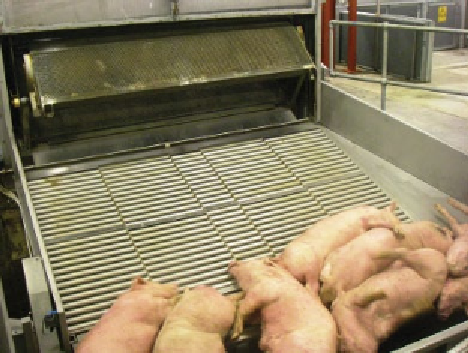Agriculture Reference
In-Depth Information
of 80-95% CO
2
in air should be utilised with sufficient
exposure time to kill the majority of the pigs and render
others unconscious until death occurs by exsanguina-
tion. If the concentration is too low, the pigs will not be
properly stunned; if it is too high, pigs may become stiff,
show reflex muscular activity and bleed poorly. If the
exposure period is too long, superficial congestion of the
skin occurs and when pigs are scalded the skin is bluish
in colour.
The type of
apparatus
employed to administer the gas
depends mainly upon the required rate of slaughter.
1
The
oval tunnel
is now largely historic but was used for
killing rates of up to 600 pigs/hour. As the name sug-
gests the gas tunnel is in the form of an oval through
which a slot conveyor carries the pigs, the actual tun-
nel sloping downwards at an angle of 30° to the anaes-
thetising chamber. On exit, the pigs are shackled,
hoisted to an overhead rail and bled. The actual con-
veyor in the tunnel is divided into 10 compartments,
one pig being accommodated in each compartment.
Pigs up to 113 kg can be handled in this equipment,
which is not suitable for other species.
2
The
dip lift
is suitable for any size of pig, as well as
calves and sheep. It consists of a cage 200 cm long,
70 cm high and 50 cm wide which, when the animal
enters it, descends vertically to the CO
2
pit where it
remains for the pre-set time and then automatically
returns to ground level, ejecting the unconscious
animal for shackling and bleeding. The greatest
advantage of the system is that it allows several pigs
to be stunned simultaneously, assisting immediate
pre-slaughter handling. This is suitable for low
throughput establishments.
3
The Compact CO
2
stunner, was the second system to
be developed and consists of a horizontally revolving
apparatus divided into four to eight compartments
each holding one animal. It operates in such a way
that, when one section is uppermost for loading, the
others are rotating to submerge in the gas chamber.
Once the pig is loaded, the floor flips down and the pig
is suspended in the cage, supported on each side, to
minimise escape behaviour. The unit usually has a
capacity of up to 600 pigs/hour. In a commonly used
design, the pigs are exposed to 10% CO
2
at the first
position, 30% for 10 seconds at the second, 60% for
10 seconds at the third and over 90% for 20 seconds at
the fourth and fifth, after which the pigs are dis-
charged from the unit.
4
The 'Compact stunner' was developed into the
'Combi-compact stunner' which is similar to the
'Compact' but permits three or four pigs per compart-
ment allowing group loading and is consequently
less stressful to the pigs. The group loading system
can be partially automated using panels fitted with
sensor which gently ease group of pigs into the system
(Fig. 7.5).
With all systems, the chamber must be fitted with a
device for measuring the gas concentration
at the point of
maximum exposure and for giving a clearly visible and
audible warning if the concentration of the gas concen-
tration falls below the required level. All systems should
allow efficient evacuation of the pigs in the event of
mechanical failure.
The
advantages
claimed for carbon dioxide stunning/
killing include relaxed carcases, allowing easier dehair-
ing and dressing, less noise and reduced labour require-
ments. It has also been contended that the yield of blood
from pigs stunned by this method is 0.75% better because
carbon dioxide stimulates respiration and thus favours
blood circulation and consequently bleeding. Muscular
Figure 7.5
CO
2
anaesthesia. Combi-compact system showing convenient shackling position after stunning (Reproduced with permission
from David Armstrong).


